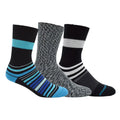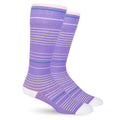How Do Compression Socks Work?
Posted by SIMON LIM

How do compression socks work? This is a question that many people have asked, and the answer is not always simple. Let's look at the science behind compression socks and how they work to improve blood flow in the legs.
Basics of Compression Socks
Compression socks are designed to apply pressure to the lower leg, which in turn helps to improve blood flow. The pressure is usually measured in millimeters of mercury (mmHg) and is most commonly between 15-20 mmHg. Compression socks are made from various materials, including elastic, nylon, and spandex. They are often knee-high or thigh-high and come in multiple colors and styles.
How Do Compression Socks Work?

The science behind compression socks is based on the principle of graduated compression. To put it simply, compression socks help your veins do their job by applying pressure and helping to improve blood flow. When you wear compression socks, it squeezes your veins and surrounding tissue, which then helps to push blood up towards your heart.
Compression of the veins in your feet and legs makes it easier for the arteries that transport oxygenated blood to relax and allow blood to flow more easily. This reduces the amount of work that your heart has to do to return the blood through your veins. Ultimately, compression socks can help keep blood close to the heart and head, reducing blood pooling in the feet.
This is why compression socks are often used to help prevent or treat conditions like venous insufficiency, deep vein thrombosis, and phlebitis. By applying pressure to the veins and surrounding tissue, compression socks can help to improve circulation and reduce swelling.
How Efficient are Compression Socks?
A few different factors contribute to the efficacy of compression socks. The first is the amount of pressure that is applied. For example, compression socks that are too loose will not provide enough pressure to be effective. On the other hand, compression socks that are too tight can actually cause more harm than good by cutting off circulation. It is crucial to find a balance in order to get the most benefit from compression socks.
Another factor contributing to the efficacy of compression socks is the material they are made from. Different materials provide different compression levels, so it is essential to choose a material that will provide the level of compression you need. For example, if you are suffering from venous insufficiency, you may need a stronger compression level than someone who is healthy and is just looking to prevent phlebitis.
Takeaways

Compression socks are a great way to improve circulation and reduce swelling. How do compression socks work? They work based on the principle of graduated compression.
Graduated compression means that the sock is tighter at the ankle and gradually becomes less tight as it goes up the leg. The pressure applied to the veins and surrounding tissue helps push blood up towards the heart. A few different factors contribute to the efficacy of compression socks, such as the amount of pressure that is applied and the material they are made from.
Find the right level of compression to get your legs feeling energized again.
SHARE:




































